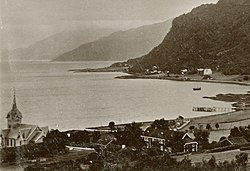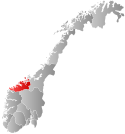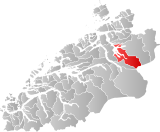Stangvik is a former municipality in Møre og Romsdal county, Norway. The 437-square-kilometre (169 sq mi) municipality existed from 1838 until its dissolution in 1965. The municipality of Stangvik (historically spelled Stangvig) encompassed much of the area surrounding the Trongfjorden and the smaller fjords that branch off of it such as the Ålvundfjorden, Stangvikfjorden, and Todalsfjorden. The municipality was mostly located in what is now Surnadal Municipality and also small portions of what is now Sunndal Municipality and Tingvoll Municipality. The administrative centre of the municipality was the village of Stangvik where Stangvik Church is located.[3]
Stangvik Municipality
Stangvik herred | |
|---|---|
| Stangvig herred (historic name) | |
 View of the village of Stangvik (early 1900s) | |
 Møre og Romsdal within Norway | |
 Stangvik within Møre og Romsdal | |
| Coordinates: 62°55′10″N 08°28′05″E / 62.91944°N 8.46806°E | |
| Country | Norway |
| County | Møre og Romsdal |
| District | Nordmøre |
| Established | 1 Jan 1838 |
| • Created as | Formannskapsdistrikt |
| Disestablished | 1 Jan 1965 |
| • Succeeded by | Surnadal and Sunndal |
| Administrative centre | Stangvik |
| Area (upon dissolution) | |
• Total | 437 km2 (169 sq mi) |
| Population (1965) | |
• Total | 3,534 |
| • Density | 8.1/km2 (21/sq mi) |
| Demonym | Stangvikgjelding[1] |
| Time zone | UTC+01:00 (CET) |
| • Summer (DST) | UTC+02:00 (CEST) |
| ISO 3166 code | NO-1564[2] |
History
editThe municipality of Stangvig was established on 1 January 1838 (see formannskapsdistrikt law). According to the 1865 census, the municipality had a population of 2,619.[4] On 1 January 1874, a part of Stangvik (population: 61) was moved to neighboring Tingvoll Municipality. Then on 1 January 1877, another part of Stangvik (population: 50) was moved to Surnadal Municipality.[5]
In 1879, parts of Surnadal (population: 83) and Halsa Municipality (population: 279) were moved to Stangvik. On 1 January 1886, the Møklegjerdet farm (population: 29), just west of Glærem, was transferred from Stangvik to Surnadal. On 1 January 1897, the Sjøflot farm (population: 27), also just west of Glærem, was transferred from Stangvik to Surnadal. On 1 May 1895, the area around the Åsskardfjorden and the Hamnesfjorden in the northern part of Stangvik was split off from Stangvik to constitute the new municipality of Aasgaard, leaving Stangvik with 2,354 inhabitants.[5]
During the 1960s, there were many municipal mergers across Norway due to the work of the Schei Committee. On 1 January 1965, the municipality of Stangvik ceased to exist. The district around the village of Ålvund and the Ålvundfjorden (population: 508) was moved to the neighboring Sunndal Municipality, the district around the villages of Åsprong and Sandnes (population: 26) was moved to the neighboring Tingvoll Municipality, and the rest of Stangvik (population: 1,386), along with Åsskard Municipality, was merged into Surnadal Municipality.[5]
Name
editThe municipality (originally the parish) is named after the old Stangvik farm (Old Norse: Stangarvík) since the first Stangvik Church was built there. The first element is derived from the genitive case of the word stǫng which means "staff" or "pole". This is likely referring to the very straight shape of the shoreline in this area (rather unusual for the very craggy shoreline in western Norway). The last element is vík which means "bay" or "cove".[6]
Government
editWhile it existed, this municipality was responsible for primary education (through 10th grade), outpatient health services, senior citizen services, unemployment, social services, zoning, economic development, and municipal roads. During its existence, this municipality was governed by a municipal council of directly elected representatives. The mayor was indirectly elected by a vote of the municipal council.[7]
Municipal council
editThe municipal council (Herredsstyre) of Stangvik was made up of 21 representatives that were elected to four year terms. The party breakdown of the final municipal council was as follows:
| Party name (in Norwegian) | Number of representatives | |
|---|---|---|
| Labour Party (Arbeiderpartiet) | 11 | |
| Christian Democratic Party (Kristelig Folkeparti) | 3 | |
| Centre Party (Senterpartiet) | 7 | |
| Total number of members: | 21 | |
| Party name (in Norwegian) | Number of representatives | |
|---|---|---|
| Labour Party (Arbeiderpartiet) | 9 | |
| Christian Democratic Party (Kristelig Folkeparti) | 3 | |
| Centre Party (Senterpartiet) | 7 | |
| Local List(s) (Lokale lister) | 2 | |
| Total number of members: | 21 | |
| Party name (in Norwegian) | Number of representatives | |
|---|---|---|
| Labour Party (Arbeiderpartiet) | 10 | |
| Joint List(s) of Non-Socialist Parties (Borgerlige Felleslister) | 11 | |
| Total number of members: | 21 | |
| Party name (in Norwegian) | Number of representatives | |
|---|---|---|
| Labour Party (Arbeiderpartiet) | 12 | |
| Joint List(s) of Non-Socialist Parties (Borgerlige Felleslister) | 12 | |
| Total number of members: | 24 | |
| Party name (in Norwegian) | Number of representatives | |
|---|---|---|
| Labour Party (Arbeiderpartiet) | 7 | |
| Joint List(s) of Non-Socialist Parties (Borgerlige Felleslister) | 9 | |
| Total number of members: | 16 | |
| Party name (in Norwegian) | Number of representatives | |
|---|---|---|
| Labour Party (Arbeiderpartiet) | 11 | |
| Local List(s) (Lokale lister) | 13 | |
| Total number of members: | 24 | |
| Party name (in Norwegian) | Number of representatives | |
|---|---|---|
| Labour Party (Arbeiderpartiet) | 13 | |
| Joint list of the Farmers' Party (Bondepartiet) and the Liberal Party (Venstre) | 6 | |
| Joint List(s) of Non-Socialist Parties (Borgerlige Felleslister) | 5 | |
| Total number of members: | 24 | |
| Note: Due to the German occupation of Norway during World War II, no elections were held for new municipal councils until after the war ended in 1945. | ||
See also
editReferences
edit- ^ "Navn på steder og personer: Innbyggjarnamn" (in Norwegian). Språkrådet.
- ^ Bolstad, Erik; Thorsnæs, Geir, eds. (26 January 2023). "Kommunenummer". Store norske leksikon (in Norwegian). Kunnskapsforlaget.
- ^ Thorsnæs, Geir, ed. (22 February 2017). "Stangvik - tidligere kommune". Store norske leksikon (in Norwegian). Kunnskapsforlaget. Retrieved 15 April 2019.
- ^ Registreringssentral for historiske data. "Hjemmehørende folkemengde Møre og Romsdal 1801-1960" (in Norwegian). University of Tromsø.
- ^ a b c Jukvam, Dag (1999). Historisk oversikt over endringer i kommune- og fylkesinndelingen (PDF) (in Norwegian). Statistisk sentralbyrå. ISBN 9788253746845.
- ^ Rygh, Oluf (1908). Norske gaardnavne: Romsdals amt (in Norwegian) (13 ed.). Kristiania, Norge: W. C. Fabritius & sønners bogtrikkeri. p. 400.
- ^ Hansen, Tore; Vabo, Signy Irene, eds. (20 September 2022). "kommunestyre". Store norske leksikon (in Norwegian). Kunnskapsforlaget. Retrieved 1 January 2023.
- ^ "Kommunevalgene 1963" (PDF) (in Norwegian). Oslo: Statistisk sentralbyrå. 1964. Retrieved 24 April 2020.
- ^ "Kommunevalgene og Ordførervalgene 1959" (PDF) (in Norwegian). Oslo: Statistisk sentralbyrå. 1960. Retrieved 24 April 2020.
- ^ "Kommunevalgene og Ordførervalgene 1955" (PDF) (in Norwegian). Oslo: Statistisk sentralbyrå. 1957. Retrieved 24 April 2020.
- ^ "Kommunevalgene og Ordførervalgene 1951" (PDF) (in Norwegian). Oslo: Statistisk sentralbyrå. 1952. Retrieved 24 April 2020.
- ^ "Kommunevalgene og Ordførervalgene 1947" (PDF) (in Norwegian). Oslo: Statistisk sentralbyrå. 1948. Retrieved 24 April 2020.
- ^ "Kommunevalgene og Ordførervalgene 1945" (PDF) (in Norwegian). Oslo: Statistisk sentralbyrå. 1947. Retrieved 24 April 2020.
- ^ "Kommunevalgene og Ordførervalgene 1937" (PDF) (in Norwegian). Oslo: Statistisk sentralbyrå. 1938. Retrieved 24 April 2020.